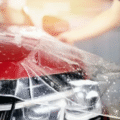A Deep Dive into Hand-Washing vs. Automatic Car Wash
When it comes to cleaning your car, there are two main methods: hand-washing and automatic car washes. Both methods serve the same purpose—getting your car clean—but the way they do it and the results they offer can be quite different. In this blog, we will explore both car washing methods, their pros and cons, and help you decide which one is the best for you.
What is Hand-Washing?
Hand-washing is the traditional method of washing a car manually. It involves using your hands, soap, water, and various tools to clean the vehicle from top to bottom. You will need a sponge or microfiber cloth to scrub the surface, a brush for hard-to-reach places, and a hose for rinsing. Hand-washing can be done at home or at a car wash station where professionals offer the service.

How Does Hand-Washing Work?
- Preparation – You start by gathering your car-washing supplies, such as soap, a bucket, a microfiber cloth, and a hose.
- Pre-Rinse – The first step is to rinse your car with water to remove any loose dirt and debris.
- Soap Application – After rinsing, you apply car wash soap to the car’s surface using a sponge or cloth.
- Scrubbing – Gently scrub the car in circular motions, ensuring you don’t damage the paint.
- Rinse Again – After scrubbing, rinse the car thoroughly to remove all soap and dirt.
- Drying – The final step is drying the car with a clean, soft towel or microfiber cloth to prevent water spots.
What is Automatic Car Wash?
An automatic car wash, also known as a drive-thru or tunnel car wash, is a machine-operated system that cleans your vehicle without manual labor. You simply drive your car into the wash, and the machine does all the work. These car washes use powerful brushes, water jets, soap, and air dryers to clean the car.
How Does an Automatic Car Wash Work?
- Drive-In – You drive your car into the automatic car wash bay.
- Pre-Soak – The machine sprays the car with water and a pre-soak detergent to loosen dirt.
- Scrubbing – The machine’s rotating brushes or soft cloth strips scrub the car’s exterior.
- Rinse – After the car is scrubbed, water jets rinse away the soap and dirt.
- Drying – The machine dries the car using high-powered air dryers.
Hand-Washing vs. Automatic Car Wash: Key Differences
1. Level of Control
Hand-Washing
One of the main advantages of hand-washing is the level of control you have over the cleaning process. You can focus on specific areas of your car, such as the wheels, tires, or any stubborn spots that need extra attention. If you notice dirt stuck in a particular place, you can work on it until it’s fully clean.
Automatic Car Wash
In an automatic car wash, the machine handles everything. While this is convenient, you have less control over the process. The machine may not clean all areas as thoroughly, and some areas, like around the mirrors or tires, might be missed.
2. Time Efficiency
Hand-Washing
Hand-washing takes time and effort. If you do it yourself, it could take anywhere from 30 minutes to an hour, depending on your skill level and the size of your car. However, it is a good exercise if you enjoy the process and don’t mind spending enough time.
Automatic Car Wash
The biggest advantage of an automatic car wash is its speed. You can get your car cleaned in just a few minutes, making it a perfect option for those who are in a hurry or don’t have the time to wash their car manually.
Pros and Cons of Hand-Washing
Pros:
- More Attention to Detail: You can focus on cleaning each part of your car thoroughly.
- Less Risk of Damage: When done properly, hand-washing can be gentler on your car’s paint.
- Customizable: You can choose the cleaning products and techniques that suit your car.
- Better for Sensitive Cars: If you have a luxury car or classic car, hand-washing is typically gentler.
Cons:
- Time-Consuming: Hand-washing takes longer time compared to automatic car washes.
- Physical Effort: It requires effort and can be tiring, especially if you’re washing a large car.
- Inconsistent Results: If you’re not experienced, you might miss spots or leave water spots behind.
Pros and Cons of Automatic Car Wash
Pros:
- Convenient: Quick and easy, no effort required on your part.
- Time-Saving: Gets the job done in just a few minutes.
- Consistent Results: The machine will provide uniform cleaning every time.
- Affordable: Most automatic car washes are a little bit cheaper and can fit into a busy schedule.
Cons:
- Less Thorough: Machines may miss certain spots or fail to clean stubborn dirt effectively.
- Risk of Damage: If the brushes are too harsh, they can scratch your car’s paint.
- Potential for Water Spots: Since automatic car washes use water jets, your car might end up with water spots if not dried properly.
Which One Should You Choose?
The decision between hand-washing and automatic car washes depends on your personal preferences, the type of car you have, and your available time. Let’s break it down to make it easier for you to decide.
When Should You Choose Hand-Washing?
- If You Value Quality: If you want the most thorough clean and are willing to spend extra time, hand-washing is the way to go.
- If You Have a Luxury Car: For high-end vehicles or classic cars, hand-washing ensures that no harsh brushes damage the paint.
- If You Enjoy the Process: Some car owners love washing their cars as it’s their hobby. If you find the process relaxing, hand-washing is the ideal option.
- If You Want to Focus on Details: Hand-washing allows you to pay extra attention to tricky areas, like the wheels and grill.
When Should You Choose an Automatic Car Wash?
- If You’re Short on Time: If you need a quick clean, an automatic car wash is the way to go.
- If You Need Convenience: When you want to get in and out of a car wash procedure quickly, automatic car washes are perfect for busy schedules.
- If You Want a Consistent Wash: Automatic washes offer the same level of cleanliness every time, so it’s a reliable option.
Tips for the Best Car Wash Experience
Whether you choose hand-washing or an automatic car wash, here are some tips to get the best results:
1. Choose the Right Products
For hand-washing, always use car-specific soap instead of household dish soap. Dish soap can strip off protective wax layers from your car. Similarly, if you’re using an automatic car wash, ensure it uses gentle, non-abrasive brushes and high-quality cleaning products.
2. Avoid Washing Your Car in Direct Sunlight
It’s best to wash your car in the shade or when it’s not too hot outside. Washing your car in direct sunlight can cause water spots to form because the soap and water will dry too quickly.
3. Dry Your Car Properly
After hand-washing or using an automatic wash, make sure to dry your car thoroughly to avoid water spots. Use a microfiber towel for best results.
Conclusion
Both hand-washing and automatic car washes have their own sets of advantages and disadvantages. Hand-washing offers a more detailed, customizable clean, making it ideal for those who want to take extra care of their vehicles. On the other hand, automatic car washes are fast, convenient, and cost-effective, making them perfect for people who are short on time.
Ultimately, the choice between hand-washing and automatic car washes depends on your needs and preferences. If you want a quick, affordable wash, an automatic car wash is the way to go. But if you want to ensure that every part of your car is spotless and well-maintained, hand-washing might be the better option.
By understanding the differences between the two methods, you can make an informed decision that keeps your car looking its best. Happy washing!










